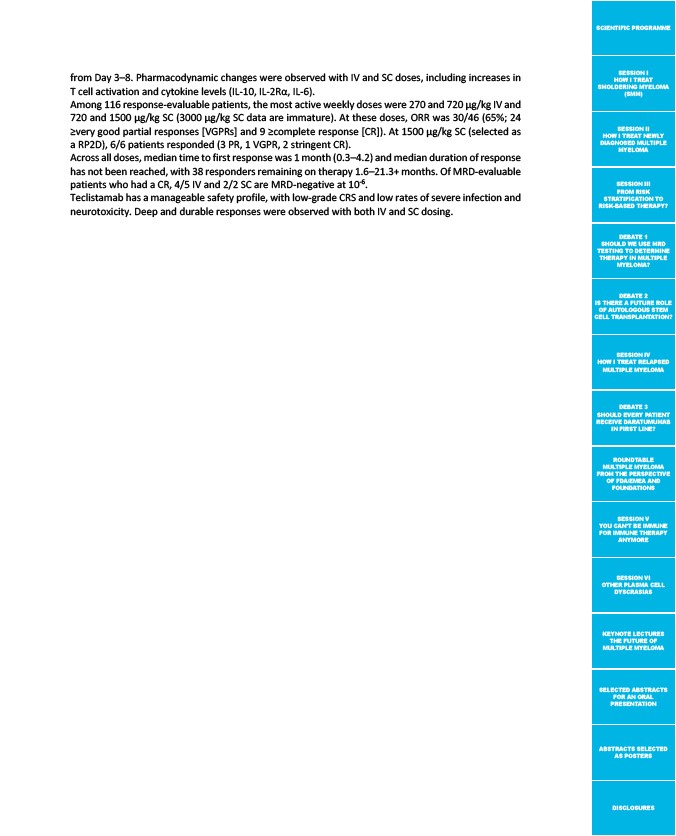
SCIENTIFIC PROGRAMME
SESSION I
HOW I TREAT
SMOLDERING MYELOMA
(SMM)
SESSION II
HOW I TREAT NEWLY
DIAGNOSED MULTIPLE
MYELOMA
SESSION III
FROM RISK
STRATIFICATION TO
RISK-BASED THERAPY?
DEBATE 1
SHOULD WE USE MRD
TESTING TO DETERMINE
THERAPY IN MULTIPLE
MYELOMA?
DEBATE 2
IS THERE A FUTURE ROLE
OF AUTOLOGOUS STEM
CELL TRANSPLANTATION?
SESSION IV
HOW I TREAT RELAPSED
MULTIPLE MYELOMA
DEBATE 3
SHOULD EVERY PATIENT
RECEIVE DARATUMUMAB
IN FIRST LINE?
ROUNDTABLE
MULTIPLE MYELOMA
FROM THE PERSPECTIVE
OF FDA/EMEA AND
FOUNDATIONS
SESSION V
YOU CAN’T BE IMMUNE
FOR IMMUNE THERAPY
ANYMORE
SESSION VI
OTHER PLASMA CELL
DYSCRASIAS
KEYNOTE LECTURES
THE FUTURE OF
MULTIPLE MYELOMA
SELECTED ABSTRACTS
FOR AN ORAL
PRESENTATION
ABSTRACTS SELECTED
AS POSTERS
DISCLOSURES
from Day 3–8. Pharmacodynamic changes were observed with IV and SC doses, including increases in
T cell activation and cytokine levels (IL-10, IL-2Rα, IL-6).
Among 116 response-evaluable patients, the most active weekly doses were 270 and 720 μg/kg IV and
720 and 1500 μg/kg SC (3000 μg/kg SC data are immature). At these doses, ORR was 30/46 (65%; 24
≥very good partial responses VGPRs and 9 ≥complete response CR). At 1500 μg/kg SC (selected as
a RP2D), 6/6 patients responded (3 PR, 1 VGPR, 2 stringent CR).
Across all doses, median time to first response was 1 month (0.3–4.2) and median duration of response
has not been reached, with 38 responders remaining on therapy 1.6–21.3+ months. Of MRD-evaluable
patients who had a CR, 4/5 IV and 2/2 SC are MRD-negative at 10-6.
Teclistamab has a manageable safety profile, with low-grade CRS and low rates of severe infection and
neurotoxicity. Deep and durable responses were observed with both IV and SC dosing.